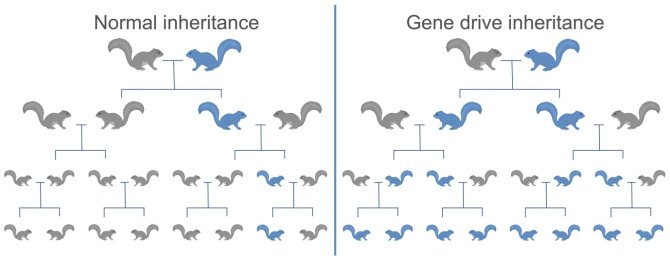
News
Model study confirms potential of sustainable genetic population control of invasive alien species
Gene drive technology, a form of genetic-biological engineering, offers a highly promising approach to biodiversity protection and pest management. A recently published model study confirms this technology’s potential by showing that it can effectively contribute to controlling grey squirrel populations in the UK. These squirrels originate from North America and now form a threat to indigenous squirrels, woodland birds and trees in the UK.
A gene drive is an advanced genetic engineering application based on the CRISPR-Cas technique, which makes it possible to relatively quickly and permanently spread a genetic feature through a large portion of an organism’s population. Spreading occurs per generation and is therefore most effective in organisms with a short generation span. Gene drives can only be used for organisms that reproduce sexually.
Laboratory of Genetics
The developments around gene drives are currently in the research phase. PhD student Nicky Faber, affiliated with the Laboratory of Genetics, is one of the WUR researchers currently working on this topic. A model study she performed has recently resulted in a publication in Scientific Reports. The model study, carried out during Faber’s graduation internship at the Roslin Institute in Edinburgh, shows that a gene drive causing infertility in female squirrels can potentially keep this species’ population under control in the UK.
A threat to indigenous squirrels, woodland birds and trees
The grey squirrel (Sciurus carolinensis) has become invasive in the UK since it was introduced from the USA in the nineteenth century. The grey squirrel is now widespread throughout the UK and invasive colonies also appear in other places, like Northern Italy. Grey squirrels severely affect the indigenous population of red squirrels (Sciurus vulgaris), they disturb the natural regeneration of woodlands by stripping bark off trees, and probably also negatively impact biodiversity among indigenous woodland birds on whose eggs and young they prey.
Sustainable alternative to current population control strategy
“As with many invasive species across the world, there’s no good way to keep grey squirrel numbers under control,” says Faber. “It’s currently done by shooting, trapping and poisoning. These measures are all inhumane, not specific to the problematic species, and unsuitable for addressing the scope of the problem.”
A gene drive has the potential to solve the problem in a sustainable way. Faber: “The gene drive is a modified gene that is inherited by all offspring rather than only half (see image below). This means that the gene spreads among the population and, after a set number of generations, all grey squirrels will carry the gene drive in their genome. The gene drive in this study was developed for population control and causes infertility in female grey squirrels whose parents both carry the gene drive. Once grey squirrels with a gene drive are released into a population, the gene drive will spread and ultimately lead to many females becoming infertile. As a result, fewer young are born and the population declines.”

Little risk to other populations
In Faber’s study a gene drive was developed that eliminates resistance alleles against the gene drive; these can sometimes develop in a population and prevent the gene drive from spreading. The gene drive is also self-limiting, which is an important safety mechanism. The gene drive developed in Faber’s study runs out after a number of generations and stops spreading. By introducing new carriers, the gene drive can continue to spread with little risk to other populations.
Opportunities for nature conservation and biodiversity
A few other examples of invasive species for which there is no effective population control strategy at present include rats, stoats and possums in New Zealand, cane toads and rabbits in Australia, rats and mice in Hawaii, and Asian carps in various places worldwide. Technologies for genetic-biological population control, like gene drives, can provide an effective, species-specific and humane alternative for keeping these invasive species in check.
“Besides population control of invasive species, other options that are currently being explored include population control or immunisation of malaria mosquitoes and other disease spreaders, immunisation of vulnerable species endangered by specific pathogens, and crop pest control,” says Faber.
Follow-up research
Although research on gene drives has already overcome a number of hurdles, there is still a lot of work to do. One of the current challenges is that researchers don’t know how well a gene drive works in a genetically diverse population in the wild. So far, gene drives have only been tested in genetically homogenous laboratory populations. However, finding out how the performance of a gene drive is affected by genetic diversity is crucial to make well-informed decisions. Research on this aspect of gene drives is currently being carried out at the Laboratory of Genetics.